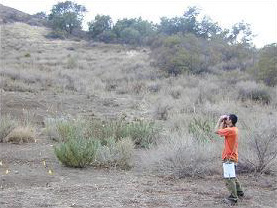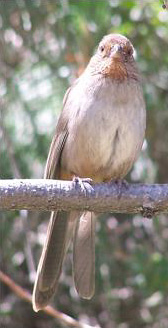Effects of Restoration on Birds
Monitoring Objectives
In spring 2006 we employed spot mapping over a chronosequence of sites at three different stages of restoration. In addition to these sites we are also surveying birds in matched pristine coastal sage scrub (pristine) and artichoke thistle-dominated (invaded) sites for comparison. The goal of our study was to monitor bird abundance, species composition, breeding behavior, and potentially estimate territory density at various sites. We selected a wide range of sites that have been undergoing restoration from two to six years. As these sites increase with age we suspected bird communities would resemble that of pristine sites. (California Towhee picture taken by Debbie Gley)
Methods
 Our spot mapping focused on five restoration sites, each matched with an invaded site and pristine site, giving us a total of 15 separate sub-sites. The three sub-sites were selected for similarity in slope, aspect and size (Fig. 1). All sites were surveyed 13 times using spot mapping between April and June. Surveys lasted 15-35 minutes based on site size. Field assistants recorded all species encountered on a paper map of the site along with behavioral observations, such as singing, foraging, carrying nesting material or food, and fledgling provisioning. These behaviors were then ranked using a reproductive index so relative breeding success could be determined. For example, a bird seen feeding fledglings is the highest rank this reproductive index, whereas a bird only seen would be ranked the lowest. The combination of behavior and community composition information gives a good indicator of which birds (species and numbers) are using the habitats and how they are using them. In addition to behavioral data we estimated territory density at each site with spot mapping.
Our spot mapping focused on five restoration sites, each matched with an invaded site and pristine site, giving us a total of 15 separate sub-sites. The three sub-sites were selected for similarity in slope, aspect and size (Fig. 1). All sites were surveyed 13 times using spot mapping between April and June. Surveys lasted 15-35 minutes based on site size. Field assistants recorded all species encountered on a paper map of the site along with behavioral observations, such as singing, foraging, carrying nesting material or food, and fledgling provisioning. These behaviors were then ranked using a reproductive index so relative breeding success could be determined. For example, a bird seen feeding fledglings is the highest rank this reproductive index, whereas a bird only seen would be ranked the lowest. The combination of behavior and community composition information gives a good indicator of which birds (species and numbers) are using the habitats and how they are using them. In addition to behavioral data we estimated territory density at each site with spot mapping.
Long-term point counts are conducted in two sites (site 1 and site 2 of spot mapping Fig. 1) undergoing coastal sage scrub (CSS) restoration, from baseline then throughout the restoration process. These restoration sites are matched with a nearby pristine CSS site (Fig. 1). Since 2004 point counts have been conducted during fall (late October), winter (Late March), spring (late May) and summer (late July) seasons. Sites are visited on two consecutive mornings, or as close as possible, each season. We used fixed radius point counts to measure species composition and relative abundance. Although all birds seen and heard are recorded, only birds seen or heard within the 50m diameter circle were used in this summary. Point count stations were within sub-sites and at least 250m apart. Ideally, counts started at dawn, where upon arrival at each site there is a one to two minute delay before starting a point count for a 10 minute duration.
 Results
Results
Spot Mapping
Figure 1. Site and sub-site map
Figure 2. Richness by restoration year
Figure 3. Richness by site and sub-site
Figure 4. Abundance by restoration year
Figure 5. Abundance by site and sub-site
Figure 6. Common (species seen five or more times at a sub-site) species richness
Figure 7. Number of male territories by site and sub-site
Table 1. Ranking of observed behaviors by a reproductive success index
Point Count
Table 2. Yearly point count summary
Summary
 We learned a lot from our spot mapping study. Our results suggest older restoration sites had greater number of bird species and overall bird numbers (Fig. 2, 3, 4, 5). This generally held true for species that were commonly using these sites as well (Fig. 6). We defined a common species as one seen at a site five or more times throughout the season. Most of the highest ranked breeding success behaviors, such as fledglings observed and adult food carries, were observed in pristine and restoration sites (Table 1). This demonstrates that some of our restoration sites are used within bird breeding territories, which indicates that some species of birds are actually using our restoration sites to rear young. Only nest location and nest material carries were observed in invaded sites. We observed no provisioning trips or fledglings in invaded sites. From our spot mapping we also estimated the number of male territories per site (Fig. 7). In general we found greater number of territories in pristine sites compared with invaded sites. The number of male territories generally increased with restoration site age in most sites, except for site five. Determining territory boundaries around singing males can be rather subjective, so this data should be interpreted with caution.
We learned a lot from our spot mapping study. Our results suggest older restoration sites had greater number of bird species and overall bird numbers (Fig. 2, 3, 4, 5). This generally held true for species that were commonly using these sites as well (Fig. 6). We defined a common species as one seen at a site five or more times throughout the season. Most of the highest ranked breeding success behaviors, such as fledglings observed and adult food carries, were observed in pristine and restoration sites (Table 1). This demonstrates that some of our restoration sites are used within bird breeding territories, which indicates that some species of birds are actually using our restoration sites to rear young. Only nest location and nest material carries were observed in invaded sites. We observed no provisioning trips or fledglings in invaded sites. From our spot mapping we also estimated the number of male territories per site (Fig. 7). In general we found greater number of territories in pristine sites compared with invaded sites. The number of male territories generally increased with restoration site age in most sites, except for site five. Determining territory boundaries around singing males can be rather subjective, so this data should be interpreted with caution.
Our point count data yielded similar results to our spot mapping results (Table 2), as the youngest restoration station (1-R) had the fewest number of species per year (cumulative species richness) and the lowest average number of individuals per survey (mean abundance). In addition, pristine sites had a greater mean abundance and typically a greater cumulative richness than their matched restoration count station. However, in 2005 station 2-R had a higher cumulative species richness than its matching pristine 2-P station (Table 2). This result is probably due to the restoration site’s proximity to an oak woodland and mature coastal sage scrub. Because both these habitats, and the restoration site, were enclosed in the 50 meter point count, the likelihood of encountering mores species increased due to the proximity of different habitat types. When comparing sites by year, cumulative richness increased between years in all but 2-R; however, mean abundance actually decrease in all stations in 2006. The reason for latter may be due to unequal number of surveys between years, thus yearly comparisons should be made with caution. Mean abundance increased in station 2-R from 2004, and actually decreased in station 1-R from 2005 to 2006 (Table 2). These loose trends are most likely attributed to vegetation cover. Station 2-R increased in vegetation cover from CSS restoration between 2004 and 2006, as the majority 1-R’s exotic vegetation was removed in 2006. Thus, 2005 1-R represents baseline data before non-chemical weed removal occurred. Although thistle-dominated sites do not tend to support a large number of species or individuals, it seems such thistle-dominated areas support more individual birds when compared to mostly bare ground with little vegetative structure (ex. station 1-R for most of 2006).
Special Thanks to:
Sonoran Joint Venture (funding source), Stacee Lockhard and Debbie Gley (field work and map summarization), Becky Stewart (protocol development), Gail Hall (grant writing)
How to Get Involved
Contact the Director of Research and Education:
Dr. Sandy DeSimone
100 Bell Canyon Rd, Trabuco Canyon, CA 92679
; (949) 858-0309
